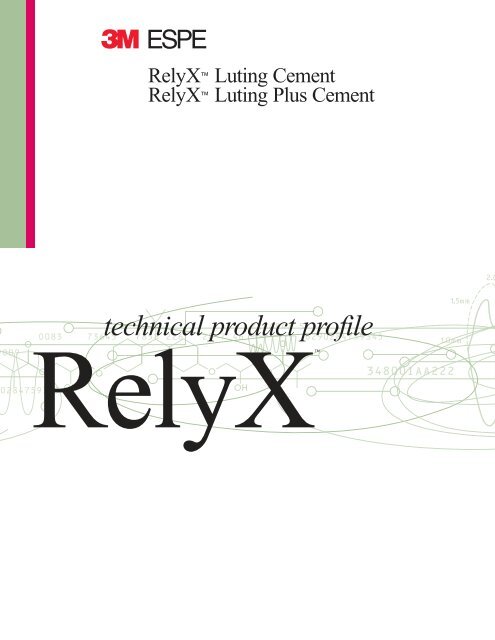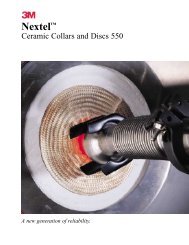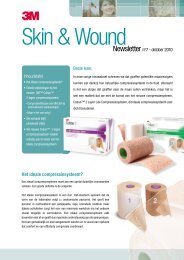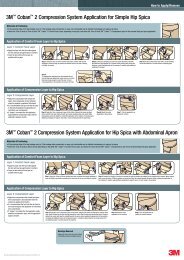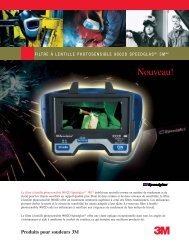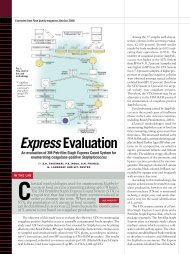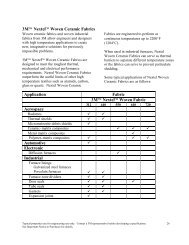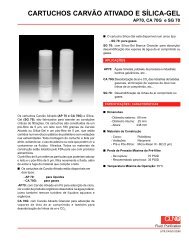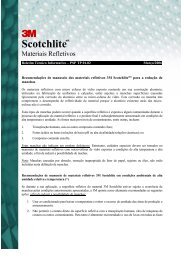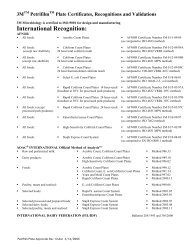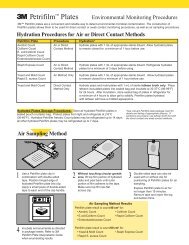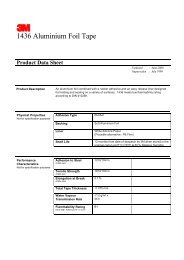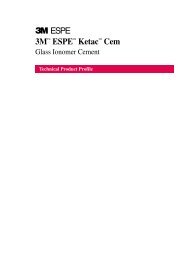RelyX™ Luting and RelyX™ Luting Plus Cement - 3M
RelyX™ Luting and RelyX™ Luting Plus Cement - 3M
RelyX™ Luting and RelyX™ Luting Plus Cement - 3M
Create successful ePaper yourself
Turn your PDF publications into a flip-book with our unique Google optimized e-Paper software.
RelyX <strong>Luting</strong> <strong>Cement</strong><br />
RelyX <strong>Luting</strong> <strong>Plus</strong> <strong>Cement</strong><br />
technical product profile<br />
RelyX<br />
TM
Table of Contents<br />
Introduction . . . . . . . . . . . . . . . . . . . . . . . . . . . . . . . . . . . . . . . . . . . . . . . . . . . . . . . . . . . . . . . .5<br />
History . . . . . . . . . . . . . . . . . . . . . . . . . . . . . . . . . . . . . . . . . . . . . . . . . . . . . . . . . . . . . . . . . . . .5<br />
Product Description . . . . . . . . . . . . . . . . . . . . . . . . . . . . . . . . . . . . . . . . . . . . . . . . . . . . . . . . . .8<br />
Indications for Use . . . . . . . . . . . . . . . . . . . . . . . . . . . . . . . . . . . . . . . . . . . . . . . . . . . . . . . . . .8<br />
Composition . . . . . . . . . . . . . . . . . . . . . . . . . . . . . . . . . . . . . . . . . . . . . . . . . . . . . . . . . . . . . . .9<br />
Properties . . . . . . . . . . . . . . . . . . . . . . . . . . . . . . . . . . . . . . . . . . . . . . . . . . . . . . . . . . . . . . . . .10<br />
Technique Guides . . . . . . . . . . . . . . . . . . . . . . . . . . . . . . . . . . . . . . . . . . . . . . . . . . . . . . . . . .17<br />
Instructions for Use . . . . . . . . . . . . . . . . . . . . . . . . . . . . . . . . . . . . . . . . . . . . . . . . . . . . . . . . .19<br />
Questions <strong>and</strong> Answers . . . . . . . . . . . . . . . . . . . . . . . . . . . . . . . . . . . . . . . . . . . . . . . . . . . . . .25<br />
Technical Data Summary . . . . . . . . . . . . . . . . . . . . . . . . . . . . . . . . . . . . . . . . . . . . . . . . . . . .26<br />
3
Introduction<br />
RelyX <strong>Luting</strong> <strong>Cement</strong> <strong>and</strong> RelyX <strong>Luting</strong> <strong>Plus</strong> <strong>Cement</strong> from <strong>3M</strong> ESPE are self-curing,<br />
radiopaque, fluoride-releasing, resin-modified glass ionomer luting cements. They are indicated<br />
for the permanent cementation of metal-based <strong>and</strong> strengthened-core ceramic restorations, posts<br />
<strong>and</strong> orthodontic appliances.<br />
The primary purpose of a luting cement is to aid in retaining <strong>and</strong> sealing fixed prosthetic devices<br />
to prepared teeth. The better the crown preparation on the tooth (long axial walls with an approximate<br />
6° taper) <strong>and</strong> the better the crown fit at the margins, the less a clinician has to rely on the<br />
retentive properties of the cement. Glass ionomer-based cements provide excellent properties for<br />
the retention of these types of restorations.<br />
The RelyX <strong>Luting</strong> cement <strong>and</strong> RelyX <strong>Luting</strong> <strong>Plus</strong> cement will provide for molecular bonding to<br />
the tooth surface without the use of a separate tooth conditioner, good strength properties, fluoride<br />
ion release, <strong>and</strong> low solubility or acid erosion of the margins in an easy to use, non-technique sensitive<br />
procedure.<br />
History<br />
Clinicians have many options for luting routine crown <strong>and</strong> bridge restorations. They range from<br />
zinc phosphates, polycarboxylates, conventional glass ionomers, resin-modified glass ionomers,<br />
compomers <strong>and</strong> resin cements. In the North American markets, the conventional <strong>and</strong> resin-modified<br />
glass ionomer luting cements have become the most frequently used for routine crown <strong>and</strong><br />
bridge restorations. Resin cements have been used for special situations where added retention is<br />
required, however they traditionally required multiple steps <strong>and</strong> have been technique sensitive.<br />
However, with the introduction of the unique RelyX Unicem Self-Adhesive Universal Resin<br />
<strong>Cement</strong> from <strong>3M</strong> ESPE, clinicians now have an easy to use resin cement that offers low potential<br />
for sensitivity <strong>and</strong> is gaining in popularity for these types of restorations.<br />
A comparison of the various classes of luting cements is provided in Table 1.<br />
5
6<br />
Table 1. <strong>Luting</strong> <strong>Cement</strong> Comparison<br />
Strengths Areas of Application Weaknesses<br />
Zinc Phosphate <strong>Cement</strong><br />
Over 100 years of clinical Routine application in Occasional postoperative<br />
experience<br />
Polycarboxylate <strong>Cement</strong><br />
metal supported crowns<br />
<strong>and</strong> bridges<br />
sensitivity<br />
Low hardness<br />
High solubility<br />
25 years of clinical experience Acceptable for retention<br />
of metal supported crowns<br />
<strong>and</strong> bridges<br />
High solubility<br />
Low fluoride ion release Long-term provisional<br />
restorations<br />
Low hardness<br />
Molecular bonding to the<br />
tooth surface<br />
Low postoperative sensitivity<br />
Conventional Glass Ionomer <strong>Cement</strong><br />
20 years of clinical experience Routine application for Occasional postoperative<br />
Fluoride ion release<br />
metal supported crowns<br />
<strong>and</strong> bridges<br />
sensitivity<br />
Molecular bonding to the Limited application with Sensitive to water <strong>and</strong><br />
tooth surface high strength ceramics mechanical loading<br />
Minimal dimensional change<br />
Simplicity of use<br />
Medium material strength<br />
Good routine cement<br />
Solubility<br />
Resin-Modified Glass Ionomer <strong>Cement</strong><br />
10 years of clinical experience Routine application for Moisture sensitive<br />
metal supported crowns<br />
<strong>and</strong> bridges<br />
powder<br />
Fluoride ion release Swelling/linear expansion<br />
Molecular bonding Limited application with<br />
to the tooth surface<br />
Low solubility or erosion<br />
of cement margins<br />
Simplicity of use<br />
Medium material strength<br />
Good routine cement<br />
Low postoperative sensitivity<br />
high strength ceramics
Strengths Areas of Application Weaknesses<br />
Compomer <strong>Cement</strong>s<br />
Easy technique Metal-supported restorations Little long-term<br />
experience<br />
Good adhesive qualities<br />
(with pretreatment:<br />
Most all-ceramic systems Moisture sensitive<br />
etching, priming, bonding) Indirect composite<br />
restorations<br />
Low or no fluoride release<br />
Low solubility Lining material<br />
Good mechanical properties Emergency provisional<br />
restoration<br />
Resin <strong>Cement</strong>s (Composite)<br />
10-20 years of clinical experience All metal-based, ceramic Difficult to use<br />
<strong>and</strong> indirect composite<br />
restorations<br />
High adhesion with use of Requires use of separate<br />
pretreatments (etching, priming, primers or adhesives<br />
bonding)<br />
High hardness Difficult clean up<br />
Low solubility Technique sensitive<br />
High mechanical properties No or little fluoride<br />
release<br />
Good esthetics Potential for<br />
postoperative sensitivity<br />
Self-Adhesive Resin <strong>Cement</strong>s (RelyX Unicem Self-Adhesive Resin <strong>Cement</strong> from <strong>3M</strong> ESPE)<br />
New self-adhesive technology All metal-based, ceramic Limited long-term<br />
<strong>and</strong> indirect composite<br />
restorations with the<br />
exception of veneers<br />
clinical history<br />
High adhesion without use of Available only in capsule<br />
etchant, primer or adhesive delivery<br />
Ease of use<br />
Capsule delivery system<br />
Low potential for postoperative<br />
sensitivity<br />
High hardness<br />
Low solubility<br />
High mechanical properties<br />
Good esthetics<br />
Easy clean up<br />
Low fluoride release<br />
7
8<br />
Product Description<br />
RelyX <strong>Luting</strong> <strong>Cement</strong> (formerly known as Vitremer <strong>Luting</strong> <strong>Cement</strong> when first launched) was<br />
first introduced into the market in 1994. The product consists of a powder <strong>and</strong> liquid, which are<br />
dispensed in a 1:1 scoop:drop ratio, <strong>and</strong> mixed by h<strong>and</strong> for 30 seconds. The working time of the<br />
mixed cement is 2.5 minutes. The resulting mix has a mousse-like consistency, which is easily<br />
loaded into the restoration <strong>and</strong> allows for easy seating of the restoration. The excess cement is<br />
then easily cleaned-up after 2-3 minutes in the mouth. The RelyX <strong>Luting</strong> cement quickly gained<br />
in popularity of use for its ease of use, h<strong>and</strong>ling <strong>and</strong> clean-up properties, <strong>and</strong> low incidence of<br />
post-operative sensitivity. It has been a market leader for many years.<br />
As with any h<strong>and</strong>-mixed, powder/liquid system, there can occasionally be an issue with the ease<br />
of use <strong>and</strong> consistency in dispensing the proper powder/liquid ratios, which if not done properly,<br />
can result in variance of the setting properties of the cement. Additionally, some of the powders<br />
can be sensitive to moisture uptake or contamination, which can also result in a variance of the<br />
setting properties of the cement. Therefore, there has been a strong desire to develop an easier to<br />
use paste/paste system that would overcome these variables <strong>and</strong> provide a product that could<br />
deliver greater consistency of use.<br />
RelyX <strong>Luting</strong> <strong>Plus</strong> <strong>Cement</strong> is a paste/paste, resin-modified glass ionomer luting cement dispensed<br />
in a larger Clicker Dispenser system from <strong>3M</strong> ESPE. The Clicker dispenser is similar to<br />
the Clicker dispenser used with the RelyX ARC Resin <strong>Cement</strong> system also from <strong>3M</strong> ESPE, but<br />
is 2.3 times larger. The RelyX <strong>Luting</strong> <strong>Plus</strong> cement pastes are easily dispensed out of the Clicker<br />
dispenser <strong>and</strong> h<strong>and</strong>-mixed for 20 seconds. The working time of the mixed cement is 2.5 minutes.<br />
As with the powder/liquid system, the mixed cement from the paste/paste has the same mousselike<br />
consistency, which is easily loaded into the restoration, <strong>and</strong> allows for easy seating of the<br />
restoration. The excess cement can also be easily cleaned up after 2 minutes in the mouth with<br />
final set being achieved in 5 minutes. The paste/paste system will provide for an even easier to<br />
use system <strong>and</strong> provide for more consistent use when compared to the powder/liquid system.<br />
For both RelyX <strong>Luting</strong> cement <strong>and</strong> RelyX <strong>Luting</strong> <strong>Plus</strong> cement, the setting reactions are very similar.<br />
Two setting reactions occur for each system, an acid-base reaction between the fluoroaluminosilicate<br />
glass <strong>and</strong> the methacrylate functionalized polycarboxylic acid (this is the true glass<br />
ionomer setting reaction) <strong>and</strong> a free radical polymerization of the pendant methacrylate groups<br />
of the polymer <strong>and</strong> HEMA (2-hydroxyetyhlmethacrylate). The free radical polymerization reaction<br />
takes place without the need for light activation, therefore it is self-curing. The additional<br />
methacrylate reactions provides for higher strengths <strong>and</strong> reduced marginal solubility without sacrificing<br />
adhesion or fluoride release. Because of this chemistry, the cements can be described as<br />
resin-modified glass ionomer cements.<br />
Indications for Use<br />
RelyX <strong>Luting</strong> cement <strong>and</strong> RelyX <strong>Luting</strong> <strong>Plus</strong> cement are indicated for luting the following types<br />
of restorations:<br />
• Porcelain-fused-to-metal (PFM) crowns <strong>and</strong> bridges<br />
• Metal crowns, bridges, inlays <strong>and</strong> onlays<br />
• Prefabricated metal provisional crowns<br />
• Strengthened core all-zirconia or all-alumina ceramic crowns <strong>and</strong> bridges<br />
(i.e. Lava All-Ceramic System from <strong>3M</strong> ESPE or Procera® AllCeram)<br />
• Prefabricated or cast posts<br />
• Orthodontic appliances
Composition<br />
RelyX <strong>Luting</strong> <strong>Cement</strong><br />
RelyX <strong>Luting</strong> cement is composed of a powder <strong>and</strong> a liquid. The powder <strong>and</strong> liquid are mixed in<br />
a1.6: 1 ratio by weight, which equates to 1 scoop of powder to 1 drop of liquid.<br />
The RelyX <strong>Luting</strong> cement powder is composed of a radiopaque fluoroaluminosilicate glass (FAS<br />
glass). It contains a microencapsulated potassium persulfate <strong>and</strong> ascorbic acid catalyst system providing<br />
the methacrylate cure in the absence of light (self-cure). The powder also contains an opacifying<br />
agent for shading to allow differentiation from the tooth.<br />
The RelyX <strong>Luting</strong> cement liquid is an aqueous solution of polycarboxylic acid modified with pendant<br />
methacrylate groups. It also contains HEMA, water <strong>and</strong> small amounts of tartaric acid.<br />
Powder Liquid<br />
Fluoroaluminosilicate (FAS) glass Methacrylated polycarboxylic acid<br />
Potassium persulfate Water<br />
Ascorbic acid HEMA<br />
Opacifying agent Tartaric Acid<br />
RelyX <strong>Luting</strong> <strong>Plus</strong> <strong>Cement</strong><br />
RelyX <strong>Luting</strong> <strong>Plus</strong> cement is composed of two separate pastes dispensed out of the Clicker <br />
Dispenser in a 1:1 volume ratio.<br />
The RelyX <strong>Luting</strong> <strong>Plus</strong> cement Paste A is composed of a radiopaque fluoroaluminosilicate glass<br />
(FAS glass), opacifying agent, HEMA, water, a proprietary reducing agent that allows for the selfcure<br />
methacrylate setting, <strong>and</strong> a dispersion aid.<br />
The RelyX <strong>Luting</strong> <strong>Plus</strong> cement Paste B is composed of a non-reactive zirconia silica filler, the<br />
methacrylated polycarboxylic acid, HEMA, BisGMA, water <strong>and</strong> potassium persulfate.<br />
Paste A Paste B<br />
Fluoroaluminosilicate (FAS) glass Methacrylated polycarboxylic acid<br />
Proprietary reducing agent BisGMA<br />
HEMA HEMA<br />
Water Water<br />
Opacifying agent Potassium persulfate<br />
Zirconia silica filler<br />
9
10<br />
Source: <strong>3M</strong> ESPE Laboratory<br />
test data<br />
Properties<br />
In order to achieve proper performance, the cements must provide for a variety of physical<br />
properties with respect to adhesion, strength, film thickness, work time, set time <strong>and</strong> radiopacity.<br />
The glass ionomer based cements are regulated under the ISO 9917:2003 st<strong>and</strong>ard for Dental<br />
Water Based <strong>Cement</strong>s <strong>and</strong> Self-curing Resin Modified <strong>Cement</strong>s. The RelyX <strong>Luting</strong> <strong>Cement</strong><br />
<strong>and</strong> RelyX <strong>Luting</strong> <strong>Plus</strong> <strong>Cement</strong> both pass the requirements for the ISO 9917 st<strong>and</strong>ard.<br />
The physical properties of the RelyX <strong>Luting</strong> cement <strong>and</strong> RelyX <strong>Luting</strong> <strong>Plus</strong> cement are described<br />
<strong>and</strong> shown in this section. Additionally, results for the following cements are also provided for<br />
most tests:<br />
GC’s FujiCEM (paste/paste resin modified glass ionomer)<br />
GC’s Fuji <strong>Plus</strong> (powder/liquid resin modified glass ionomer)<br />
GC’s Fuji 1® (powder/liquid conventional glass ionomer)<br />
Adhesion to Tooth Structure<br />
An advantage of the glass ionomer cements is their inherent ability to provide a molecular bond<br />
to tooth structure without the use of separate etching <strong>and</strong> bonding techniques. Although, some<br />
products do recommend the use of a separate conditioner on the tooth surface to promote adhesion,<br />
RelyX <strong>Luting</strong> cement <strong>and</strong> RelyX <strong>Luting</strong> <strong>Plus</strong> cement do not need a separate conditioning<br />
step. While the adhesion is lower than that of properly placed composite resin systems, clinical<br />
experience has proven it to be adequate for most metal-based or strengthened-ceramic restorations.<br />
Bovine dentin <strong>and</strong> enamel substrates were prepared by potting the teeth in acrylic, then grinding<br />
<strong>and</strong> polishing to expose the enamel or dentin surface. S<strong>and</strong>blasted metal test buttons were used to<br />
simulate the restoration. <strong>Cement</strong>s were mixed according to manufacturer’s directions <strong>and</strong> placed<br />
onto the metal surface. The metal buttons were then seated onto the tooth surface under moderate<br />
pressure. The samples were placed into a heated humidity chamber (37°C/95%RH) for 20 minutes,<br />
<strong>and</strong> then placed into distilled water. The samples were stored at 37°C for 24 hours <strong>and</strong> the<br />
shear adhesion results were measured using an Instron test machine. Figures 1 <strong>and</strong> 2 show the<br />
adhesion results for both enamel <strong>and</strong> dentin. RelyX <strong>Luting</strong> cement <strong>and</strong> RelyX <strong>Luting</strong> <strong>Plus</strong> cement<br />
show similar results for adhesion.<br />
MPa<br />
12<br />
10<br />
8<br />
6<br />
4<br />
2<br />
0<br />
RelyX<br />
<strong>Luting</strong><br />
<strong>Plus</strong><br />
RelyX<br />
<strong>Luting</strong><br />
FujiCEM Fuji 1®<br />
RelyX<br />
<strong>Luting</strong><br />
<strong>Plus</strong><br />
RelyX<br />
<strong>Luting</strong><br />
FujiCEM Fuji 1®<br />
Figure 1. Shear Adhesion to Enamel Figure 2. Shear Adhesion to Dentin<br />
MPa<br />
10<br />
8<br />
6<br />
4<br />
2<br />
0
Adhesion to Core Build-Up Substrates<br />
In addition to bonding to tooth structure, the cements must also be able to bond to various types of<br />
core build-up materials that may be used as a base under indirect restorations. The common types<br />
of build-up materials include amalgam, glass ionomer, <strong>and</strong> composite resins. In this test, the<br />
cements were tested for adhesion in a similar manner to that described above for the dentin <strong>and</strong><br />
enamel.<br />
MPa<br />
20<br />
16<br />
12<br />
8<br />
4<br />
0<br />
RelyX<br />
<strong>Luting</strong> <strong>Plus</strong><br />
RelyX<br />
<strong>Luting</strong><br />
Figure 3. Adhesion to Core Build-up Substrates<br />
Adhesion to Restorative Substrates<br />
In addition to bonding to the tooth structure <strong>and</strong> the core build-up substrates, the cements must<br />
also be able to bond to the various restorative substrates, for which they are indicated. The primary<br />
restorative substrates that are indicated for the resin-modified glass ionomers are metal, alumina<br />
<strong>and</strong> zirconia. In this test, the cements were tested s<strong>and</strong>blasted metal (Rexillium III), Lava All-<br />
Ceramic zirconia <strong>and</strong> Procera® AllCeram alumina buttons were bonded to enamel in a similar<br />
procedure as described above.<br />
18<br />
16<br />
14<br />
12<br />
10<br />
MPa<br />
8<br />
6<br />
4<br />
2<br />
0<br />
RelyX<br />
<strong>Luting</strong> <strong>Plus</strong><br />
RelyX<br />
<strong>Luting</strong><br />
Figure 4. Adhesion to Restorative Substrates<br />
FujiCEM Fuji <strong>Plus</strong> Fuji 1®<br />
FujiCEM Fuji <strong>Plus</strong> Fuji 1®<br />
Amalgam<br />
Glass Ionomer<br />
Composite<br />
Metal<br />
Zirconia<br />
Alumina<br />
Source: <strong>3M</strong> ESPE Laboratory<br />
test data<br />
Source: <strong>3M</strong> ESPE Laboratory<br />
test data<br />
11
12<br />
Source: <strong>3M</strong> ESPE Laboratory<br />
test data<br />
Mechanical Properties<br />
A metal-based <strong>and</strong> strengthened-core ceramic restoration gains much of its supporting strength<br />
<strong>and</strong> stability from the coping <strong>and</strong> does not rely as heavily on the cement as is the case with weaker<br />
strength ceramics where composite resin cements are indicated <strong>and</strong> needed for support. The compressive<br />
<strong>and</strong> flexural strength of the cements were measured in accordance with the ISO 9917 test<br />
st<strong>and</strong>ard. Additionally, the diametral tensile strength of the cements was also measured. The<br />
cements tested provided for similar results for the three strength measurements with the exception<br />
of the Fuji 1® 1 conventional glass ionomer, which was significantly lower for flexural strength.<br />
MPa<br />
250<br />
200<br />
150<br />
100<br />
50<br />
0<br />
RelyX<br />
<strong>Luting</strong><br />
<strong>Plus</strong><br />
RelyX<br />
<strong>Luting</strong><br />
Figure 5. Compressive Strength Figure 6. Diametral Tensile Strength<br />
40<br />
30<br />
MPa 20<br />
10<br />
0<br />
RelyX<br />
<strong>Luting</strong><br />
<strong>Plus</strong><br />
RelyX<br />
<strong>Luting</strong><br />
Figure 7. Flexural Strength<br />
FujiCEM Fuji 1®<br />
FujiCEM Fuji 1®<br />
30<br />
25<br />
20<br />
MPa 15<br />
10<br />
5<br />
0<br />
RelyX<br />
<strong>Luting</strong><br />
<strong>Plus</strong><br />
RelyX<br />
<strong>Luting</strong><br />
FujiCEM Fuji 1®
Film Thickness<br />
The film thickness of the cement plays an important role in determining how well a precision indirect<br />
restoration will fit. Film thickness is determined by placing the mixed cement between two<br />
glass plates <strong>and</strong> placing a load on the top plate to see how thin the cement layer can get. A material<br />
with a low film thickness has the ability to allow a very tight fitting indirect restoration to seat<br />
completely. This test was conducted in accordance with ISO 9917 <strong>and</strong> requires the film thickness<br />
to be less than 25 microns. The results show that all of the cements were below the 25 micron<br />
limit.<br />
microns<br />
Figure 8. Film Thickness<br />
Radiopacity<br />
Radiopacity is important during an indirect procedure for two reasons, it allows the doctor to discover<br />
any excess material subgingivally <strong>and</strong> allows the doctor to discover any large marginal discrepancies.<br />
Radiopacity allows the clinician to distinguish the cement from tooth structure on an<br />
x-ray. The radiopacity was measured in accordance with the ISO 9917 test st<strong>and</strong>ard. The test compares<br />
the radiographical density of the cement test sample to that of aluminum. A value of 1.0 or<br />
greater is considered to be radiopaque. The results show that all of the cements were in a similar<br />
range are considered to be radiopaque.<br />
mm Al<br />
25<br />
20<br />
15<br />
10<br />
2.5<br />
2<br />
1.5<br />
1<br />
0.5<br />
0<br />
5<br />
0<br />
RelyX<br />
<strong>Luting</strong><br />
<strong>Plus</strong><br />
Figure 9. Radiopacity<br />
RelyX<br />
<strong>Luting</strong><br />
RelyX RelyX<br />
<strong>Luting</strong> <strong>Plus</strong> <strong>Luting</strong><br />
FujiCEM Fuji 1®<br />
FujiCEM Fuji 1®<br />
Source: <strong>3M</strong> ESPE Laboratory<br />
test data<br />
Source: <strong>3M</strong> ESPE Laboratory<br />
test data<br />
13
14<br />
Source: <strong>3M</strong> ESPE Laboratory<br />
test data<br />
Source: <strong>3M</strong> ESPE Laboratory<br />
test data<br />
Fluoride Release<br />
One of the key features of a glass ionomer-based cement is their sustained fluoride release. It is<br />
generally believed that the release of fluoride ions <strong>and</strong> uptake into the tooth structure aids in the<br />
reduction of secondary caries 1 , which can be difficult to detect under a crown or bridge. Fluoride<br />
release was measured in-vitro in a buffer solution using a fluoride ion-specific electrode. The chart<br />
shows the sustained release of both RelyX <strong>Luting</strong> <strong>Cement</strong> <strong>and</strong> RelyX <strong>Luting</strong> <strong>Plus</strong> <strong>Cement</strong> in<br />
comparison to the other resin-modified glass ionomers <strong>and</strong> the conventional glass ionomer<br />
(Ketac Cem Glass Ionomer <strong>Luting</strong> <strong>Cement</strong> from <strong>3M</strong> ESPE).<br />
µg/g<br />
9000<br />
8000<br />
7000<br />
6000<br />
H<br />
J<br />
B<br />
H<br />
J<br />
B<br />
H<br />
B<br />
J<br />
B<br />
H<br />
BJ<br />
F<br />
F<br />
F F<br />
5000<br />
4000<br />
3000<br />
F<br />
2000<br />
F<br />
1000<br />
0<br />
1 21 41 61 81 101<br />
Days<br />
121 141 161 181<br />
Figure 10. Cumulative Fluoride Release<br />
Field Evaluation Results<br />
With the introduction of the RelyX <strong>Luting</strong> <strong>Plus</strong> cement, a clinical use field evaluation was conducted.<br />
137 dentists cemented a total of 1889 restorations with the RelyX <strong>Luting</strong> <strong>Plus</strong> cement.<br />
The observation period was approximately 6 weeks. The dentists completed a questionnaire<br />
regarding their experiences in use <strong>and</strong> application of the product.<br />
The dentists that participated in the study used a variety of cement types for their routine cementation<br />
including resin cements, resin-modified glass ionomers, conventional glass ionomers, polycarboxylates,<br />
<strong>and</strong> zinc phosphate.<br />
Figure 11 shows the range <strong>and</strong> numbers of types of restorations that were placed during the<br />
evaluation.<br />
Other<br />
Provisional stainless steel crowns<br />
Pins or posts<br />
Strengthened-core ceramics<br />
Metal inlays or onlays<br />
Metal-based bridges<br />
Metal-based crowns<br />
Figure 11. Types of Restorations<br />
1 Hicks MJ, Flaitz CM, Quintessence Int. 2000 Sep;31(8): 570-8.<br />
H<br />
J<br />
0 300 600 900 1200 1500<br />
Restorations Type<br />
H<br />
J<br />
B<br />
B RelyX <strong>Luting</strong> <strong>Plus</strong><br />
J RelyX <strong>Luting</strong><br />
H FujiCEM<br />
F Fuji <strong>Plus</strong><br />
Ketac Cem
Clinicians were asked to rate various h<strong>and</strong>ling properties of the RelyX <strong>Luting</strong> <strong>Plus</strong> <strong>Cement</strong> on a<br />
scale of 1 to 5 with a 1 being completely dissatisfied <strong>and</strong> a 5 being completely satisfied.<br />
Figure 12 shows the average rating for the various properties <strong>and</strong> the percentage of clinicians that<br />
stated they were satisfied to completely satisfied. Overall, clinicians were very satisfied with all<br />
attributes <strong>and</strong> performance of the RelyX <strong>Luting</strong> <strong>Plus</strong> cement.<br />
Average Score<br />
J J J<br />
Figure 12. Overall satisfaction with RelyX <strong>Luting</strong> <strong>Plus</strong> cement<br />
Clinicians were asked to rate various properties of the new larger Clicker Dispenser on a scale<br />
of 1 to 5 with a 1 being completely dissatisfied <strong>and</strong> a 5 being completely satisfied.<br />
Figure 13 shows the average rating for the various properties <strong>and</strong> the percentage of clinicians that<br />
stated they were satisfied to completely satisfied. Overall, the clinicians were very satisfied with<br />
the new larger Clicker dispenser.<br />
Average Score<br />
5<br />
4.5<br />
4<br />
3.5<br />
3<br />
5<br />
4.5<br />
4<br />
3.5<br />
3<br />
Ease of<br />
dispensing<br />
J<br />
Ease of<br />
dispensing<br />
cement<br />
Ease of<br />
mixing<br />
Figure 13. Satisfaction with the Clicker dispenser<br />
J<br />
<strong>Cement</strong> Ability to<br />
consistency completely<br />
seat<br />
restoration<br />
J<br />
Proper mix<br />
ratios dispensed<br />
J<br />
Ability to<br />
dispense<br />
specific dose<br />
amounts<br />
J J<br />
Amount of<br />
working<br />
time<br />
J<br />
Excess<br />
cement<br />
clean up<br />
J<br />
Self-cure<br />
set time<br />
Cleanliness Ease of<br />
replacing cap<br />
J<br />
Restoration<br />
retention<br />
J<br />
Overall<br />
cement<br />
h<strong>and</strong>ling<br />
J J J<br />
J<br />
Overall<br />
satisfaction<br />
with<br />
dispensing<br />
system<br />
Size of Clicker Overall<br />
satisfaction with<br />
Clicker<br />
100<br />
80<br />
60<br />
40<br />
20<br />
0<br />
100<br />
80<br />
60<br />
40<br />
20<br />
0<br />
%Stating Satisfied to Completely Satisfied<br />
%Stating Satisfied to Completely Satisfied<br />
15
16<br />
Clinicians were also asked to rate how well the RelyX <strong>Luting</strong> <strong>Plus</strong> <strong>Cement</strong> met their overall<br />
expectations for a routine crown <strong>and</strong> bridge luting cement. They were asked to rate their satisfaction<br />
on a scale of 1 to 5 with 1 corresponding to not meeting expectations at all <strong>and</strong> a 5 corresponding<br />
to completely met expectations. Figure 14 shows the average rating for meeting expectations<br />
<strong>and</strong> the percentage of clinicians that stated that the product either generally met or completely met<br />
expectations. The results were determined for the various user groups. Overall, the cement met the<br />
clinician’s expectations very well.<br />
Average Score<br />
4.5<br />
4<br />
3.5<br />
3<br />
J<br />
Total User<br />
Group<br />
J<br />
RelyX<br />
<strong>Luting</strong> Users<br />
Figure 14. Overall Satisfaction with RelyX <strong>Luting</strong> <strong>Plus</strong> cement<br />
The clinicians that currently use the powder/liquid RelyX <strong>Luting</strong> cement were asked if they felt<br />
that the paste/paste RelyX <strong>Luting</strong> <strong>Plus</strong> cement would provide more consistent performance, by<br />
eliminating the variability with dispensing separate powders <strong>and</strong> liquids.<br />
No<br />
Figure 15. Consistency of RelyX <strong>Luting</strong> <strong>Plus</strong> cement<br />
J<br />
FujiCEM<br />
Users<br />
Yes<br />
J<br />
Other Users<br />
100<br />
80<br />
60<br />
40<br />
20<br />
0<br />
%Stating Satisfied to Completely Satisfied
Technique Guides<br />
RelyX <strong>Luting</strong> <strong>Cement</strong><br />
CROWN AND BRIDGE CEMENTATION<br />
Indications:<br />
• For permanent cementing of:<br />
- Porcelain-fused-to-metal crowns <strong>and</strong> bridges<br />
- Metal inlays, onlays, crowns <strong>and</strong> bridges<br />
- Crowns made with all-alumina or all-zirconia cores such<br />
as Procera ® AllCeram <strong>and</strong> Lava All-Ceramic System<br />
- Pre-fabricated <strong>and</strong> cast endodontic posts<br />
• <strong>Cement</strong>ing orthodontic b<strong>and</strong>s<br />
Tooth Preparation:<br />
• Remove provisional restoration <strong>and</strong> all temporary cement.<br />
• Clean tooth with oil-free pumice paste, rinse, <strong>and</strong> dry.<br />
• DO NOT DESSICATE THE TOOTH.<br />
Mixing:<br />
• Use an equal number of powder scoops<br />
<strong>and</strong> liquid drops.<br />
• Fluff the powder. Dispense 3 level scoops<br />
for crown, 6 for bridge.<br />
• Hold liquid vial vertically <strong>and</strong> dispense 3<br />
drops for crown, 6 for bridge. Keep the<br />
vial tip clean.<br />
• Mix all the powder into the liquid, about 30<br />
seconds.<br />
Load the crown/bridge:<br />
• Spread the cement over all the internal<br />
surfaces of the crown/bridge.<br />
• Working time is 2.5 minutes.<br />
Placement:<br />
• Seat the crown/bridge.<br />
• Wait at least 3 minutes after placement.<br />
• Remove excess cement with an appropriate<br />
instrument.<br />
<strong>3M</strong> ESPE Customer Hotline 1-800-634-2249 70-2009-2445-7<br />
Please refer to instructions for more detailed information 44-0019-9255-9B<br />
as well as precautionary <strong>and</strong> warranty information. © 2003 <strong>3M</strong><br />
1<br />
2<br />
3<br />
17
18<br />
RelyX <strong>Luting</strong> <strong>Plus</strong> <strong>Cement</strong><br />
CROWN AND BRIDGE CEMENTATION<br />
Indications:<br />
For permanent cementation of:<br />
• Porcelain-fused-to-metal crowns <strong>and</strong> bridges<br />
• Metal crowns, bridges, inlays <strong>and</strong> onlays<br />
(including prefabricated provisional metal crowns).<br />
• All-zirconia or all-alumina strengthened core restorations<br />
• Prefabricated or cast endodontic posts<br />
<strong>Cement</strong>ing orthodontic b<strong>and</strong>s<br />
Tooth Preparation:<br />
• Remove provisional restoration <strong>and</strong> all temporary cement.<br />
• Clean tooth with oil-free pumice paste, rinse <strong>and</strong> lightly dry<br />
leaving tooth surface moist.<br />
• DO NOT OVERDRY THE TOOTH<br />
Dispensing <strong>and</strong> Mixing:<br />
• Remove cap <strong>and</strong> dispense desired<br />
amount of cement onto mixing pad.<br />
1-2 “Clicks” of material are sufficient<br />
for a single tooth restoration.<br />
• Note: To avoid water evaporation <strong>and</strong><br />
drying out of the cement pastes, dispense<br />
<strong>and</strong> mix cement immediately prior to use.<br />
• Replace cap securely onto Clicker dispenser<br />
until an audible click is heard.<br />
• Mix cement with spatula for 20 seconds.<br />
Load <strong>Cement</strong> Into Restoration:<br />
• Working time of mixed cement is<br />
2.5 minutes.<br />
• Apply thin layer of cement to the inside<br />
surface of the restoration.<br />
Placement of Restoration:<br />
• Seat restoration with light pressure.<br />
• Excess cement can be removed after 2<br />
minutes in the mouth with an appropriate<br />
instrument (e.g. explorer, scaler).<br />
• Set time is 5 minutes after placement in<br />
the mouth.<br />
• Finish restoration <strong>and</strong> adjust occlusion.<br />
<strong>3M</strong> ESPE Technical Hotline 1-800-634-2249 70-2009-3605-5<br />
Please refer to Instructions for Use for more detailed 44-0007-4143-7<br />
information as well as precautionary <strong>and</strong> warranty information. © 2003 <strong>3M</strong><br />
1<br />
2<br />
3
Instructions for Use<br />
RelyX <strong>Luting</strong> <strong>Cement</strong><br />
Description of Product<br />
RelyX <strong>Luting</strong> cement, manufactured by <strong>3M</strong> ESPE, is a glass ionomer system comprised of two<br />
parts: a powder <strong>and</strong> a liquid. The powder is a radiopaque, fluoroaluminosilicate glass. The liquid<br />
is an aqueous solution of a modified polyalkenoic acid. RelyX <strong>Luting</strong> cement provides the major<br />
benefits of glass ionomer cements – adhesion to tooth structure, fluoride release along with additional<br />
benefits of low solubility, improved fracture toughness <strong>and</strong> a low viscosity, non-stringy,<br />
slump-resistant mix.<br />
Indications For Use<br />
RelyX <strong>Luting</strong> cement is indicated for use when luting:<br />
• Porcelain fused to metal crowns <strong>and</strong> bridges to tooth structure, amalgam, composite or glass<br />
ionomer core build-ups<br />
• Metal inlays, onlays or crowns<br />
• Crowns made with all-alumina or all-zirconia cores such as Lava All-Ceramic System or<br />
Procera® AllCeram.<br />
• Prefabricated <strong>and</strong> cast post cementation<br />
• Orthodontic appliances<br />
RelyX <strong>Luting</strong> cement is not indicated for composite or porcelain inlays or onlays, or composite or<br />
all-ceramic crowns not having all-alumina or all-zirconia cores.<br />
Precautions for Dental Personnel <strong>and</strong> Patients<br />
RelyX <strong>Luting</strong> cement liquid contains HEMA (2-hydroxyethylmethacrylate). Avoid use of this<br />
product on patients with known acrylate allergies. To reduce the risk of allergic response, minimize<br />
exposure to these materials. In particular, avoid exposure to uncured resins. Use of protective<br />
gloves <strong>and</strong> a no-touch technique is recommended. If skin contact occurs, wash skin with soap <strong>and</strong><br />
water. Acrylates may penetrate commonly used gloves. If cement contacts glove, remove <strong>and</strong> discard<br />
glove, wash h<strong>and</strong>s immediately with soap <strong>and</strong> water <strong>and</strong> then re-glove. If accidental contact<br />
with eyes or prolonged contact with oral soft tissue occurs, flush with large amounts of water. If<br />
irritation persists, consult a physician.<br />
Liquid <strong>and</strong> powder/liquid mix may cause eye irritation upon contact <strong>and</strong> may be mildly irritating<br />
to oral soft tissue upon contact. Avoid contact with eyes <strong>and</strong> minimize contact with oral soft tissue.<br />
If accidental contact with eye occurs, flush immediately with large amounts of water. If irritation<br />
persists, consult a physician.<br />
Instructions for Use<br />
1. Remove the provisional restoration <strong>and</strong> all residual temporary cement. Thoroughly clean the<br />
preparation with an oil-free pumice paste. Rinse with water <strong>and</strong> let dry.<br />
Note: Do not desiccate the tooth. Desiccation of tooth structure is believed to cause postoperative<br />
sensitivity in some individuals.<br />
19
20<br />
2. Pulp Protection: Use a hard setting calcium hydroxide material with near exposures.<br />
NOTE: Use of some tooth preparation treatments is contraindicated as their residue may<br />
adversely affect bond strength or the setting reactions (e.g., Tubulicid Red).<br />
Contact your local <strong>3M</strong> ESPE representative or the <strong>3M</strong> ESPE Customer Hotline for specific<br />
details.<br />
3. Casting preparation: Thoroughly clean interior surfaces of cast crown, inlay or onlay<br />
4. Dispense powder <strong>and</strong> liquid: The st<strong>and</strong>ard powder/liquid ratio of 1.6:1 by weight can be<br />
obtained by using an equal number of level scoops of powder <strong>and</strong> liquid drops. Three scoops<br />
of powder <strong>and</strong> three drops of liquid will provide an adequate amount of material to seat one<br />
typical crown.<br />
Shake the jar to fluff the RelyX <strong>Luting</strong> powder before dispensing. Insert the scoop into the<br />
jar, overfill it with loosely packed powder <strong>and</strong> withdraw it against the plastic leveler to<br />
remove the excess powder <strong>and</strong> obtain a level scoop. Dispense the desired number of powder<br />
scoops onto the mixing pad.<br />
Note: The glass ionomer powders are sensitive to high humidity. Store with jar caps securely<br />
tightened <strong>and</strong> away from high humidity.<br />
To obtain a proper liquid drop size, hold the RelyX <strong>Luting</strong> cement liquid vial vertically with<br />
the dropper tip down <strong>and</strong> without the tip contacting the mixing pad. Squeeze the vial to dispense<br />
the desired number of liquid drops onto the mixing pad.<br />
5. Mixing: Using a cement spatula, mix the powder into the liquid. To minimize water evaporation<br />
<strong>and</strong> maximize working time, continue spatulation of the powder <strong>and</strong> liquid to a small<br />
area of the mixing pad. All of the powder should be incorporated into the liquid within 30<br />
seconds.<br />
6. Working Time of the st<strong>and</strong>ard powder/liquid ratio is at least 2.5 minutes from the start of mix<br />
at a room temperature of 73°F (23°C). Higher temperatures <strong>and</strong> vigorous spatulation will<br />
shorten working time. Lower temperatures will lengthen working time.<br />
Note: Working time can be lengthened by using refrigerated liquid or by mixing on a cold slab.<br />
7. Crown Placement: Load the crown by spreading a layer of the cement over all the interior<br />
surfaces of the crown. Seat crown. Maintain pressure on crown to maintain position during<br />
setting process<br />
8. Clean up excess: Excess material can be removed when cement reaches a waxy stage after a<br />
minimum of 3 minutes from placement in the mouth (37°C or 98°F). Use a suitable instrument<br />
for this purpose.<br />
Storage <strong>and</strong> Use<br />
1. Shelf life at room temperature is 24 months. See outer package for expiry date.<br />
2. The glass ionomer system is designed to be used at room temperatures of approximately<br />
70-75°F (21-24°C). Replace caps immediately after use.<br />
3. Glass ionomer powders are sensitive to high humidity. Store with jar caps securely tightened<br />
<strong>and</strong> away from high humidity.<br />
4. Do not substitute Vitremer Core Buildup/Restorative powder or liquid manufactured by <strong>3M</strong><br />
ESPE, for RelyX <strong>Luting</strong> cement powder or liquid.<br />
5. No person is authorized to provide any information, which deviates from the information<br />
provided in the instruction sheet.
Warranty<br />
<strong>3M</strong> ESPE warrants this product will be free from defects in material <strong>and</strong> manufacture. <strong>3M</strong> ESPE<br />
MAKES NO OTHER WARRANTIES INCLUDING ANY IMPLIED WARRANTY OF MER-<br />
CHANTABILITY OR FITNESS FOR A PARTICULAR PURPOSE. User is responsible for<br />
determining the suitability of the product for user’s application. If this product is defective within<br />
the warranty period, your exclusive remedy <strong>and</strong> <strong>3M</strong> ESPE’s sole obligation shall be repair or<br />
replacement of the <strong>3M</strong> ESPE product.<br />
Limitation of Liability<br />
Except where prohibited by law, <strong>3M</strong> ESPE will not be liable for any loss or damage arising from<br />
this product, whether direct, indirect, special, incidental or consequential, regardless of the theory<br />
asserted, including warranty, contract, negligence or strict liability.<br />
21
22<br />
RelyX <strong>Luting</strong> <strong>Plus</strong> <strong>Cement</strong><br />
Description of Product<br />
RelyX <strong>Luting</strong> <strong>Plus</strong> cement is a self-curing, radiopaque, fluoride-releasing, resin-modified glass<br />
ionomer luting cement. The cement consists of a base <strong>and</strong> catalyst paste packaged in the Clicker <br />
Dispensing System. The paste/paste formulation offers greater convenience over the traditional<br />
powder/liquid cement systems. The cement is available in a white shade.<br />
Indications For Use<br />
• <strong>Cement</strong>ation of porcelain-fused-to-metal (PFM) crowns <strong>and</strong> bridges<br />
• <strong>Cement</strong>ation of metal crowns, bridges, inlays <strong>and</strong> onlays (including prefabricated provsional<br />
metal crowns)<br />
• <strong>Cement</strong>ation of all-alumina or all-zirconia strengthened restorations (i.e. Lava All-Ceramic<br />
System or Procera® AllCeram restorations)<br />
• <strong>Cement</strong>ation of prefabricated or cast posts<br />
• <strong>Cement</strong>ation of orthodontic appliances<br />
Precautions<br />
RelyX <strong>Luting</strong> <strong>Plus</strong> cement contains acrylate resins including HEMA (2-hydroxyethylmethacrylate).<br />
Avoid use of this product on patients with known acrylate allergies. To reduce the risk of<br />
allergic response, minimize exposure to these materials. In particular, avoid exposure to uncured<br />
resins. Use of protective gloves <strong>and</strong> a no-touch technique is recommended. If skin contact occurs,<br />
wash skin with soap <strong>and</strong> water. Acrylates may penetrate commonly used gloves. If cement contacts<br />
glove, remove <strong>and</strong> discard glove, wash h<strong>and</strong>s immediately with soap <strong>and</strong> water <strong>and</strong> then reglove.<br />
If accidental contact with eyes or prolonged contact with oral soft tissue occurs, flush with<br />
large amounts of water. If irritation persists, consult a physician.<br />
Pulp Protection<br />
Cover areas in close proximity to the pulp by applying small amounts of hard-setting calcium<br />
hydroxide material (e.g., Alkaliner MiniTip Calcium Hydroxide Liner, manufactured by <strong>3M</strong><br />
ESPE) or resin-modified glass ionomer liner (e.g., Vitrebond Light Cure Glass Ionomer<br />
Liner/Base, manufactured by <strong>3M</strong> ESPE) prior to taking an impression for the final restoration.<br />
Preparation<br />
1. Remove the temporary restoration <strong>and</strong> thoroughly clean the preparation of any temporary<br />
cement residue using an oil-free pumice paste.<br />
2. Rinse the prepared tooth or cavity with a water spray, <strong>and</strong> dry with air, cotton, or a paper tip.<br />
Leave tooth surface moist. Do not overdry.<br />
3. Try in final restoration <strong>and</strong> check for fit. Adjust if necessary.<br />
4. Thoroughly clean the bonding surface of the restoration.<br />
5. Keep area isolated from blood <strong>and</strong> saliva contamination during cementation process.
Dispensing <strong>and</strong> Application<br />
1. For first time use, remove the Clicker Dispenser from the foil package. Discard foil.<br />
2. Remove cap from the Clicker dispenser by holding down the cap lever <strong>and</strong> sliding the cap off<br />
of the dispenser.<br />
For first time use from a new cartridge, dispense a small amount of material to ensure even<br />
dispensing. Discard this material.<br />
3. Fully depress clicker lever to dispense “1 Click” of cement onto mix pad. Allow paste to fully<br />
extrude, then release lever. Repeat dispensing process for additional material. The paste is<br />
automatically dispensed in equal volumes. (The actual weight ratio dispensed is 1.3:1)<br />
Note: Dispense <strong>and</strong> mix cement immediately prior to use to avoid water evaporation <strong>and</strong> drying<br />
out of the cement pastes.<br />
4. Wipe the dispenser tips clean with gauze to prevent cross contamination of the two pastes.<br />
5. Replace cap by sliding onto dispenser until securely latched <strong>and</strong> an audible click is heard.<br />
6. Using a plastic or metal cement spatula, mix the pastes together for 20 seconds until a uniform<br />
color is achieved. Avoid the incorporation of air bubbles.<br />
The working time of the mixed cement is 2.5 minutes at 23°C/73°F. Higher temperatures <strong>and</strong><br />
longer mix times may shorten the working time. Lower temperatures will lengthen the working<br />
time.<br />
7. Apply a thin layer of cement to the inside surface of the restoration. The cement may also be<br />
applied directly to the tooth surface for inlay/onlay restorations.<br />
8. Seat the restoration with light pressure. Maintain light pressure on the restoration to hold<br />
proper positioning during setting process.<br />
Clean Up <strong>and</strong> Finishing<br />
• Remove excess cement when it has reached a waxy stage after 2 minutes from placement in<br />
the mouth. Use a suitable instrument (e.g. scaler, explorer) for this process.<br />
• Finish restoration <strong>and</strong> check occlusion when material has completely set after 5 minutes from<br />
placement in the mouth.<br />
Storage <strong>and</strong> Use<br />
• Shelf life at room temperature of an unopened foil package is 24 months. Expiry date is noted<br />
on package.<br />
• Keep dispenser in foil package until time for initial use. Once the foil pouch is opened, the<br />
shelf life of the cement in the Clicker Dispenser is 6 months. Refrigeration of material can<br />
extend shelf life. Allow material to come to room temperature prior to use.<br />
• RelyX <strong>Luting</strong> <strong>Plus</strong> <strong>Cement</strong> is designed to be used at room temperature of 21-24°C or 70-<br />
75°F.<br />
• Store Clicker paste dispensers in a cool environment. Do not expose the cement to elevated<br />
temperatures. Do not allow the pastes to dry out. Store with cap securely attached to the dispenser.<br />
23
24<br />
• The Clicker Dispenser can be cleaned <strong>and</strong> disinfected by following st<strong>and</strong>ard infection control<br />
practices for surfaces that have been touched.<br />
Warranty<br />
<strong>3M</strong> ESPE warrants this product will be free from defects in material <strong>and</strong> manufacture. <strong>3M</strong> ESPE<br />
MAKES NO OTHER WARRANTIES INCLUDING ANY IMPLIED WARRANTY OF MER-<br />
CHANTABILITY OR FITNESS FOR A PARTICULAR PURPOSE. User is responsible for<br />
determining the suitability of the product for user’s application. If this product is defective within<br />
the warranty period, your exclusive remedy <strong>and</strong> <strong>3M</strong> ESPE’s sole obligation shall be repair or<br />
replacement of the <strong>3M</strong> ESPE product.<br />
Limitation of Liability<br />
Except where prohibited by law, <strong>3M</strong> ESPE will not be liable for any loss or damage arising from<br />
this product, whether direct, indirect, special, incidental or consequential, regardless of the theory<br />
asserted, including warranty, contract, negligence or strict liability.
Questions <strong>and</strong> Answers<br />
How many applications can be done out of each system?<br />
For the RelyX <strong>Luting</strong> <strong>Cement</strong> powder/liquid system it is recommended to use 3 scoops to 3<br />
drops of liquid for a single crown. Based on these ratios, approximately 80 single units can be<br />
seated out of one set of powder <strong>and</strong> liquid.<br />
For the RelyX <strong>Luting</strong> <strong>Plus</strong> <strong>Cement</strong> paste/paste system it is recommended to dispense 2 “clicks”<br />
of material out of the Clicker Dispenser for a single crown. Based on this amount, approximately<br />
40 single units can be seated out of one Clicker dispenser. There are 80 total clicks of material out<br />
of a single Clicker dispenser. The back of the plunger has a scale that shows how many clicks are<br />
remaining in the Clicker dispenser.<br />
What is the shelf life for the cements?<br />
For the RelyX <strong>Luting</strong> cement powder/liquid system, the shelf life is 2 years. During use it is very<br />
important to make sure that powder vial is completely sealed after use to avoid moisture contamination<br />
of the powder, which can eventually cause slow setting.<br />
For the RelyX <strong>Luting</strong> <strong>Plus</strong> cement paste/paste system, the shelf life is 2 years. The cement Clicker<br />
dispenser is packaged in a foil pouch. This is to help minimize water loss out of the product. Keep<br />
the Clicker dispenser in the foil pouch until it is ready for use. Once the foil pouch is opened, the<br />
product in the Clicker dispenser then has 6 months of shelf life. Refrigeration can extend this shelf<br />
life but make sure to allow the paste to come to room temperature before trying to dispense. It is<br />
important to make sure the Clicker dispenser cap is securely latched after use to avoid water loss<br />
<strong>and</strong> drying out of the pastes.<br />
Are the RelyX <strong>Luting</strong> cement <strong>and</strong> RelyX <strong>Luting</strong> <strong>Plus</strong> cement indicated for use with<br />
ceramic restorations?<br />
The only ceramic restorations indicated are the strengthened-core ceramic restorations fabricated<br />
out of alumina (i.e. Procera® AllCeram) or zirconia (i.e. Lava All-Ceramic System).<br />
25
26<br />
Technical Data Summary<br />
RelyX <strong>Luting</strong> <strong>Plus</strong> RelyX <strong>Luting</strong> FujiCEM Fuji 1®<br />
<strong>Cement</strong> <strong>Cement</strong><br />
Compressive Strength (MPa) 160.0 ± 8.8 111.7 ± 26.0 121.0 ± 21.4 180.7 ± 22.2<br />
Diametral Tensile Strength (MPa) 25.5 ± 2.3 21.9 ± 4.4 17.6 ± 4.8 21.6 ± 1.6<br />
Flexural Strength (MPa) 31.6 ± 4.1 27.6 ± 4.3 24.8 ± 9.5 7.8 ± 4.3<br />
Shear adhesion to dentin (MPa) 5.7 + 1.8 5.0 + 4.5 1.5 + 2.2 3.2 + 1.0<br />
Shear adhesion To enamel (MPa) 10.3 + 1.8 8.4 + 2.4 5.7 + 3.4 3.3 + 1.6<br />
Shear adhesion to metal (Rexillium III) 10.5 + 2.6 7.5 + 1.1 9.6 + 3.1 6.7 + 1.6<br />
(MPa)<br />
Shear adhesion to alumina 14.2 + 1.9 11.3 + 2.9 8.6 + 1.0 2.8 + 1.6<br />
(Procera® AllCeram) (MPa)<br />
Shear adhesion to zirconia 9.2 + 2.5 14.4 + 1.5 10.6 + 2.6 2.8 + 0.5<br />
(Lava All-Ceramic) (MPa)<br />
Shear Adhesion to amalgam core build-up 8.7 + 2.7 6.6 + 1.9 4.8 + 2.8 4.4 + 1.2<br />
(MPa)<br />
Shear adhesion to glass ionomer core 6.7 + 1.9 8.4 + 1.6 5.8 + 1.2 5.4 + 1.9<br />
build-up (MPa)<br />
Shear adhesion to composite resin core 5.3 + 2.1 14.6 + 4.1 11.4 + 2.3 5.1 + 0.3<br />
build-up (MPa)<br />
Film thickness (microns) 15.3 ± 1.5 17.0 ± 2.6 11.3 ± 3.2 21.3 ± 2.5<br />
Radiopacity (mm) 1.42 ± 0.01 1.53 ± 0.02 1.32 ± 0.08 1.90 ± 0.1<br />
Source: <strong>3M</strong> ESPE Lab Test Data
Dental Products<br />
<strong>3M</strong> Center<br />
Building 275-2SE-03<br />
St. Paul, MN 55144-1000<br />
USA<br />
<strong>3M</strong> Canada<br />
Post Office Box 5757<br />
London, Ontario N6A 4T1<br />
Canada<br />
1-800-265-1840 ext. 6229<br />
10% post-consumer<br />
waste paper<br />
Printed in USA<br />
© <strong>3M</strong> 2004<br />
<strong>3M</strong>, ESPE, Alkaliner, Clicker,<br />
Ketac, Lava, MiniTip, RelyX,<br />
Vitrebond <strong>and</strong> Vitremer are<br />
registered trademarks of <strong>3M</strong><br />
ESPE or <strong>3M</strong> ESPE AG. Used<br />
under license in Canada.<br />
FujiCEM, Fuji <strong>Plus</strong> <strong>and</strong> Fuji IX GP<br />
are trademarks <strong>and</strong> Fuji I is a registered<br />
trademark of GC America.<br />
Procera is a registered trademark<br />
of Nobel Biocare AB.<br />
70-2009-3606-3


